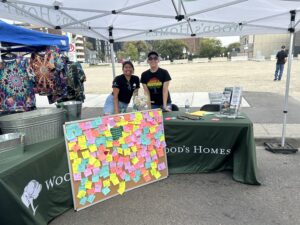By Terry Pitoulis, Wood’s Homes Research Assistant and Justine Marengo, Wood’s Homes Clinician
The COVID-19 pandemic and associated lockdowns and restrictions have been hard on all of us. We’ve all experienced increased stress and previously unforeseen challenges in our personal and work lives. But through all of it, Wood’s Homes and its staff have come together to support one another and find new and innovative ways to complete our work and continue serving our clients.
Virtual technology and communication has proven to be an invaluable tool in maintaining contact between staff and clients. The recently published special edition of the Wood’s Homes Journal Evidence to Practice: COVID-19 Special Issue on COVID-19 exemplified the many ways staff in a variety roles have relied on virtual communication (such as WebEx, Zoom, FaceTime, e-mails, and phone) (Wood’s Homes, 2021). While not always a popular method in all settings (many staff noted and continue to note the inability to effectively gauge affect and non-verbal communication cues), applications like WebEx and Zoom offer a number of alternative means of communicating and distributing information. These provide benefits not normally accessible during in-person meetings, sessions, and trainings. Two areas where virtual training and engagement have been consistently implemented is at William Taylor Learning Centre (WTLC) and agency wide with the Child and Adolescent Functional Assessment Scale (CAFAS).
WTLC has experienced varying results with virtual meetings and trainings. As a Therapeutic Learning Centre, WTLC strives to engage families in various ways as we believe their participation and input is crucial in supporting young people. This has included hosting information evenings and family connection evenings focused on providing families with valuable information on trauma, parenting, or related issues. Meeting virtually allowed WTLC staff to tailor the information sessions to better suit the families’ needs. No more need to arrange babysitters to watch other siblings, drive to a venue to listen to a speaker etc. The polling feature on WebEx chat allowed staff to ask parents more directly about what topics they would like to hear about, what times would suit them to host these meetings, and how we can better tailor these sessions to be as useful as possible to them.
Though WTLC staff were hopeful virtual sessions would lead to a surge in attendance with the removal of some practical barriers, information sessions were not well attended. Families often juggle a myriad of barriers such as lack of access to technology or busy evening lives. Staff continue to look for alternative ways to engage our families and are hopeful that by getting constant feedback we are able to find a solution that works best for our families, and in the future this may continue to include aspects of virtual engagement.
WTLC was not the only area where the impacts of virtual engagement and training have been felt. CAFAS Trainees and trainers also experienced varying successes and barriers pivoting to virtual platforms. CAFAS is a child and adolescent screening tool designed to identify the level of behavioral impairment of clients between the ages of 5 and 19 (Functional Assessment Systems, 2021). Two CAFAS training sessions were held virtually during the height of Alberta public health restrictions. Like many forms of training and testing utilized by Wood’s Homes, CAFAS training was not initially designed with virtual delivery methods in mind; however it was a unique challenge to see if we could adapt the training to ensure continuity of certifications. The switch to virtual CAFAS training resulted in several improvements and successes for trainees and trainers alike. The trainees of two trainings were asked to participate in a post-training survey where they were asked about several different facets of virtual learning. Most noteworthy was that 100% of participants agreed that they were able to adequately learn CAFAS concepts virtually, as well as being able to easily submit testing answers. As a trainer, this was encouraging in terms of the effectiveness of the training and what could be considered moving forward. The introduction of the WebEx polling feature in practice testing was also of great popularity with again 100% of trainees liking the feature, which was unsurprising given how much engagement there was during the practice and review components of the training itself. In-person trainings typically rely on a handful of trainees to be willing to share their responses out loud, which can be quite uncomfortable for some people to do as they are learning. The polling however allowed for more anonymous participation, so a broader sense of responses was actually shared for each question. Outside of the training material itself, the testing components required a bit more patience on behalf of trainers and trainees alike as final technological bugs were worked out, with some acknowledging the very clear difference between being able to receive timely feedback in a virtual setting where this process had some delays. Despite the testing design limitation, presentation delivery has remained relatively the same and the key purpose of the training seems to have been replicated effectively in a virtual setting.
Though not without its hiccups, virtual training and engagement has seen considerable integration within Wood’s Homes. As we slowly and inevitably move away from the days of lockdowns and stay-at-home orders, we will need to ask ourselves to what extent we would like to keep our virtual means of training and knowledge sharing. The impersonal nature of virtual communication is one that does not seamlessly integrate well into services that have their foundations in building connections and relationships but it cannot be denied that the ease of access, ability to maintain services in unexpected circumstances, and the comfort of remaining in familiar environments are all important benefits that should be embraced where appropriate. There is always the hope that lessons learned in these unprecedented times continue to grow our ability to adapt to changing circumstances, and the journey of integrating virtual training and engagement while mitigating barriers where possible is just one example of this ongoing adaptation at Wood’s Homes.
References
Functional Assessment Systems. (2021). Child and adolescent functional assessment scale-CAFAS. Retrieved from https://www2.fasoutcomes.com/Content.aspx?ContentID=12
Wood’s Homes. (2021). Publications. Retrieved from https://www.woodshomes.ca/learn/publications/
Parts of this work and the ability to report on these experiences were supported by funds received from Frayme through their Virtual Innovations in Care grant program.




